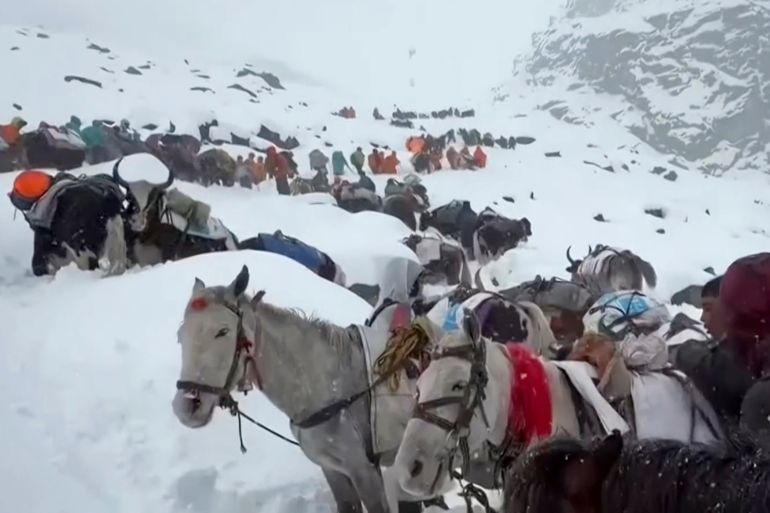Hundreds of hikers, local guides and yak herders have now reached safety after becoming stranded in freezing temperatures by a heavy snowstorm over the weekend on the east face of Mount Everest in Tibet, authorities said.
The evacuation of the last 200 or so hikers from the isolated Karma Valley on Tuesday came after about 350 trekkers were guided to safety on Sunday, marking one of the largest ever search-and-rescue operations in the region.
Recommended Stories
list of 4 itemsend of list
China’s official Xinhua news agency said that a total of 580 hikers and more than 300 local mountain guides and yak herders had arrived safely in Qudeng township and nearby areas of Dingri county in the Tibet Autonomous Region of China.
Rescue teams carrying food, medicine, oxygen supplies and materials to provide warmth had guided the almost 900 stranded trekkers and guides out of Karma Valley, which lies at an average altitude of 4,200 metres (13,800 feet) at the base of Mount Everest, after a powerful blizzard dumped heavy snowfall in the region on Friday and Saturday.
Xinhua said all the trekkers had reached safety and local government officials were now organising the return to their homes in “an orderly manner”.
The Reuters news agency said that outdoor enthusiasts had flocked to China’s rugged interior since an eight-day holiday began on October 1.
Chinese social media users have been scathing of the mass stranding on the mountain, many taking to WeChat and Douyin – the Chinese TikTok – to criticise what they see as a frivolous pastime by the wealthy in a potentially dangerous area.
One user on WeChat asked if the stranded trekkers would be charged for the cost of the huge search-and-rescue operation.
“Even when I have enough money, I still want to bury myself at the foot of Mount Everest,” said another Douyin user.
First explored by Western travellers a century ago, the Karma Valley is relatively pristine. But it is less visited compared with the north face of Everest, where there is road access.
“Thankfully, some people ahead of us were breaking trail, leaving footprints we could follow – that made it a little easier,” Eric Wen, 41, told Reuters, adding that he trudged through 19km (12 miles), most of it heavy snow, to leave the valley.
“Otherwise, it would’ve been impossible for us to make it out on our own,” he said.
Western China is dominated by the Tibetan Plateau, a vast elevated area stretching from the Himalayas on the border with Nepal to Qinghai province and the Xinjiang region in the north. It is known for its scenic, snow-capped mountains and crystal-clear lakes and is the source of the Yangtze, Mekong and other major rivers that flow down to nearby countries and other parts of China.
In neighbouring Nepal, Sherpa communities have been adapting to increasingly unpredictable conditions as climate change contributes to more frequent and dramatic climate shifts in the Himalayas, posing risks to climbers and the Sherpas who work there.
Source: Aljazeera

Leave a Reply